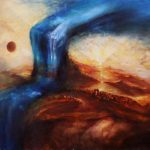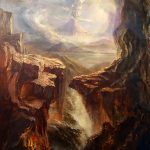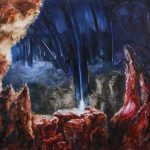[1992, Nevada County, California]
Grandma takes my beating heart in her warm hands and holds it until it softens, until it knows it is safe to open. She sings stories so it will remember things it has never felt. She lulls its redness with her touch. When the heart opens she pours in all her love and all her fears with it. She pours in all her dreaming and her bruises. She touches its tissues to her swollen lips and weeps. The muscle grows bigger with her tears. The muscle grows tender, skittish to the touch. She sets a kettle on the stove and stirs in possibility, measuring out worries in her palm before sprinkling them in. She ladles the brine into a bowl and serves it with oyster crackers. She spreads the heart with a butter knife on toast and tells me to eat, to help myself to more.





Since age five there has been one constant: transit. Joint custody, foreign exchange, weekly commutes, overseas living. I left the home I knew because there were no other options for a girl who picked up the scent of rotting bodies buried in the women around her, who saw despair seething out tiny pores and ragged cuticles, the bloodied carnage piled high from generations before her, around her, closing in. Wasted. All this utterly wasted human capacity and the lethal rage it breeds. The biting perfectionism of the frustrated woman. The broken women who break babies the way they break mustangs. At twelve, I signed a pact in blood with momma swearing I would not marry or have babies. It was a pact with myself to remain human. At the first chance: a high school exchange program in Colima, Mexico. Free, except for airfare. Only two students per semester in a school of three thousand. I applied. Anywhere. Anywhere but here. I saved money for the ticket from an afterschool job. I was sixteen. Because the violence of gendering was not taken seriously, I could not call myself a refugee. I could only say: Mexico, New Mexico, Arizona, Madrid, Sacramento, Chicago, New York, Brasília, Rio. I could only see my smiling white face in brochures and on billboards across Mexico advertising the international school I attended for free in the exchange. I could only say: I was privileged. I could only say: I was lucky enough to get away.



[August 2001, St. Louis University, Madrid campus]
I made it to college. I read Alice Walker’s recollection of three gifts her mother gave her when she left home and went off to study. I underline one gift – a sewing machine – and the rationale for it: that it was the one tool she could use to make anything she needed so she wouldn’t have to depend on anyone else. It stuck with me: the image of that sewing machine being part of feminist theory in an academia in which I felt so alien. I spent a day and a night in that basement apartment scrubbing the tile walls of their years layered in oil spatters, and in those hours, instead of the familiar shame, I felt proud of my mothers, my grandmothers. Of the practical skills they had gifted me. Of all they could give.

[September 2013, Rio de Janeiro]
I grew fascinated with language because language was the thing used to contain, to beat me into smaller pieces so that I would be easier for my family and my culture to masticate. They were busy. They didn’t have space for the room I needed. So, I studied the words, the syntaxes. I kept a spiral notebook where I composed rhyming poems, copied down strings of letters I didn’t understand and looked up their definitions. I made lists from a thesaurus of words to use in future rhyming poems. I turned to paper when punished for speaking. Dish soap and thumbs down my throat, the larynx closes. Be seen, not heard. Be accommodating and sweet. I was told terrible stories about myself, explanations for why I was so strange, so troublesome and mean. I became a bully who was bullied. I had no other way to say things. Bad words were off-limits but bad words turn toxic when kept inside a body. They eat away at the esophagus, erode the trachea. The difference between Brazilians and United Statesians, between those raised male and those raised female, it seems, has something to do with the way words are held and released.
It is strange to use text in this quilt, to employ written language in a tradition developed largely by silenced ones: the slave, the wife, the woman. But this is my reality now: writing, the privilege of my education. This is my contribution to the tradition, then. An expansion, not a breaking.
Bringing quilting into writing, integrating it: the only way this work is real. For it to exist only as Roman script on white paper would be a false making. Forced sterilization.
On paper, I cannot move my pen in a straight line. I have tried and it is terrible. Some would say good, but that’s not true. Things move sidewards. Lines round, contain too many hyphens, rests, commas, internal rhymes, refrains.

I give my head to clear thinking
My heart to greater loyalty
My hands to larger service
For my club, my community, my country, and my world.
– 4-H Pledge

[2003, California State University, Sacramento]
I design a Special Major in Chicano/Latino Literature & Art. It is not the novelty of an assumed cultural “other” that I find engaging, but the histories and articulations of rural, working class and Far West experience otherwise absent in academia. I resist the narrative that culture only travels East to West, North to South because I have seen it move in all directions. I know Indigenous America and Africa have had extensive influence on U.S. and European cultures. I know that Country & Western ballads are just boleros sung sideways and that cowboys are adaptations of Mexican vaqueros. I rebel against the cultural hegemony of an English Major. I study the ancient civilizations of this land, the Silk Road and the Islamic Empire, how Africa made its way through Portugal and Spain and into the so-called New World in ways our national narrative does not allow. I study how plants native to the Americas became the base for contemporary Italian cuisine because Italians were the only Europeans willing to experiment with fruits and vegetables new to them. I study the undocumented intermixing of our One Drop heritage, and the ways languages change and adapt just as readily as culture even in spite of institutionalized racism. It is through the language of Chicanismo that the Eurasian aunt who raised me and I can speak about our family: my Dust Bowl kin who call themselves White who were once High Germans who shame Low Germans who lie about Gypsies who marry poor Mexicans who marry poor Swedes who marry poor French Canadians who lie about any kind of Indian who marry poor Nicaraguans who marry poor Blacks who marry poor Blackfeet who marry elite Japanese who marry wealthy Englishmen who marry whomever the fuck they please. It is in the overlaps and blending, in the mestizaje I feel most at home.


[2012, Rio de Janeiro]
I cross the street to the pharmacy. The military police are outside yielding assault rifles, occupying the entrance to the favela down a side street. Rio has just secured its bid for the 2016 Olympics. I notice my visceral response to assault rifles on men in uniform is different from other passers by. I notice myself as foreign in this instance, as gringa hailing from the radical left and libertarian hills of Northern California: my response is terror, then rage. Milling around me are faces that convey we are used to this. This is normal. I mask my reaction. I enter the pharmacy, buy toilet paper, toothpaste. Commerce drones on down the boulevard: un suco de abacaxi e um pão de queijo, por favor.

[2013, Rio de Janeiro]
Apathy in a year’s time has turned to outrage, action, political mobilization. Protests one million strong all across the country finding solidarity in a global network of anonymous sites, authors. There is deep fear in the daily proof that life here is not valued. But there has been enough. Basta já! There are reverberations of Brazil’s past revolutions, of the Arab Spring, of Occupy. There is no face, only moving.
[2013, São Paulo]
We set up our table at Feira Plana, the largest artist publications fair in the country. Makers are enflamed. The medium itself again becomes an active one, full of nuance and risk. R staffs our table while I hop from press to press examining new work, swapping samples and talking shop. I return to staff our table while she tours the fair. We have become part of a traveling band of independent publishers in a place where independent publishing was long illegal. Until the mid-1800s, printing in the colonies was forbade; all published materials had to be printed in Britain and then imported from the Portuguese crown. Brazil was the last country in the Americas to acquire a printing press (Mexico was the first), let alone to legalize publishing in the colony. This is part of the reason we have found it hard to buy paper or print books locally: there is no strong tradition of papermaking or printing, and, by extension, a limited number of well-trained printers. There are letterpress printers from the Cordel tradition, but not much by way of commercial printing. Our small press had to limit a recent edition to 750 copies because that was the maximum quantity of a particular paper to be found in all the country. The past is present is not philosophy, but economics. Today at Casa do Povo, we are part of a blend of small presses, fine art presses, self-publishers, poster makers, book artists, artist-instructors, cartoonists, zine makers and poets. Many print with the aid of salvaged technologies that allow hands to smudge ink: letterpress, silkscreen, risograph, Xerox. The immediacy and resilience of our mediums are especially resonant now. Again.

You repair the thing until you remake it completely.
Louise Bourgeois
It is the compulsion of the Western fine art tradition to break from that very tradition. We call this Innovation and True Art and deny that it came from anything but Pure Genius. We are often blind to the continuity, even the continuity of the impulse to make it new.
It was not until age thirty that I could write in first person plural. It was not until age thirty that I felt entitled enough to write using the word “we,” to claim myself as part of a larger cultural conversation.
I resist the act of writing to be fully present in my body – stitching, making, moving. This need makes the shaming come alive: you are lazy, too feminine, too poor to be smart, too rural. A bumpkin. But if I keep moving, if I stay in this wordless making, I soak in its power on its own terms. I am released from the peculiar colonization of the written word upon my flesh.

[April 2014, California]
I begin sewing a welcoming quilt for my new nephew from scraps of worn-in clothing from each member of his family. Sometimes we must make a thing only for our love of the person receiving it. I am pulled to make him something to touch, something to hold over his little boy body when it feels fragile or alone or battered by this world, something to remind him he is loved. Something to protect him from the particular brutality this world holds for his little boy body.
The making of his quilt takes months away from my studio practice, places me in the bedroom with a fold-up table, sewing machine, chair. I love this making. It returns me. But, I cannot help but feel plagued by the notion that turning my making toward a loved one minimizes my work, places me back in the world of country crafts and women’s work –quilts, scrapbooks, embroidery. I have swallowed the myth of male genius, too, despite my body’s attempts to reject it. It poisons my love of other ways of making, insisting that I am less of an artist when I care for those around me, when I hold the capacity to hold them close and give.
I refuse this. I see all around me a world of makers, many of them women, equally adept at committing to their own making and at elevating those around them. I slash open a vein to drain the poison. I suck out the altered blood and spit mouthfuls on the ground. I cauterize the breakage, begin interviewing makers who also make space for others. I make plans to publish a series of these interviews, then a book.
In their most active years, members of the Royal Chicano Air Force —originally called the Rebel Chicano Art Front— did not distinguish between those who secured the grants, organized the events, repaired the engines, and those who made the artwork. This act of denying divisions was a conscious subversion of Eurocentric frameworks of art and life and culture. Or, as Dr. Ella Maria Diaz writes, “An important component of the RCAF’s creation of a Chicano/a mural environment was their collapse of artistic hierarchy in opposition to the idea of beauty and artistic genius as the realm of the individual artist.” In the tellings and retellings of their story in the popular press, however, this ideology is downplayed and the more conventional story of the RCAF as a core group of visual artists becomes History.
How does one convey a different narrative to a reader unwilling or unable to read any other way than the one they already know? The widespread exclusion of historically marginalized voices from prominent venues of culture is attributed to this unwillingness to think beyond convention.
People who have survived atrocities … witnesses as well as victims are subject to the dialectic of trauma. It is difficult for an observer to remain clearheaded and calm, to see more than a few fragments of the picture at one time, to retain all the pieces and to fit them together. It is even more difficult to find a language that conveys fully and persuasively what one has seen.
Judith Herman, M.D., Trauma and Recovery
Everywhere I carry my North American body – Brazil, Mexico, Spain, Greece, Japan as reconstructed inside the Sacramento home of my WWII-surviving great-aunt – there is a physical layer I must shed in order to be in that place. I am made acutely aware of a covering I carry in the place I most often call home, a shield crafted against the daily violence of life there. It is a different kind of shield than the one I carry in Rio on my way to work where the violence is honest – armed robberies, murders, looting. There are other kinds of violence, too: class warfare, threats of another military coup, hate crimes, rape. And yet my body remains open in particular ways as I walk the street aware of very real danger. I am guarded, yes. I am hyper-vigilant all the time. Watchful. Weary. It is exhausting. The artist Alma Leiva crystallizes this feeling in her installation-photograph series Celdas (Prison Cells), in which she recreates the interiors of homes in San Pedro Sula, the second largest city in Honduras and a narco-city now infamous for being the most violent in the world. Leiva brings outside elements such as playground sand and teeter-totters inside, giving the intimacy of home space the weight of the prison cell it becomes in a city where the danger outside seeps into everything. In her essay, “The Other Side of Fear: Alma Leiva’s Prison Cells,” Dr. Tatiana Reinoza writes, “Home spaces are records of embodied and situated knowledge that allow viewers to connect the private with the collective sphere of experience.” Reinoza goes on to cite the work of Amalia Mesa-Bains, María Brito and several artists in diaspora whose work focuses on intimate space as sites of violence and memory. These troubled intimacies are more common than we care to admit.
We drink excessively in Rio. Drinking allows dance and laughter, but the weight of history and its consequences is left unaccounted for, untended. The body doesn’t close, but it craves numbing, a safety. We spend our days off from work indoors, attempting to unravel. When I am designing Leiva’s exhibition catalog years later, the sight of her photographs causes blood to rush to the surface of my skin. The feeling that radiates from the pixels haunts, finally distilled.
In the United States, it is the body that closes. It shuts in on itself to ward off the myriad micro-assaults to the senses: separation, subdivision, the aggressive insistence of a thing called personal space, the sound of English in the way we speak it, the threat of white male terrorism that knows no consequence: mass murder, serial rape, shootings by police. My skin braces for the chill of contact: the handshake, the monotone speech that inquires about what I do for a living, the askance looks at any slip into vulnerability, desire, feeling. There is little space to be human here unless I am alone. And while solitude can be cause for elation, the prolonged isolation of one human from others causes the heart to stop. It incites death by a slow, steady calcification layered upon the flesh. This subtle closing is not the same as one that threatens immediate survival, of course, but it threatens survival all the same. The body only breaks more slowly.
And what happens when intimate space itself is a warzone? Where does the body break then?
In empire, violence becomes a proud part of family narrative. We are sons and daughters and grandchildren of heroes who fight in wars to protect our freedom. We absorb the trauma of the soldier. We treat their pain as elevated, as honorable and just. And yet our domestic homicide toll accounts for more of our own deaths than all the soldiers in all the wars we’ve fought, but we do not honor these sacrifices or their repercussions. Violence becomes a comfort when tied to home life, like the scent of vanilla or a wood-burning stove.
[1992, Nevada County, California]
Grandma dresses me in a button-down shirt, pressed with starch, dried by the fireside. She talks me through the binding of a tie, pointed at the end like my father’s, knotted perfect. Don’t you never kiss no man’s foot.































